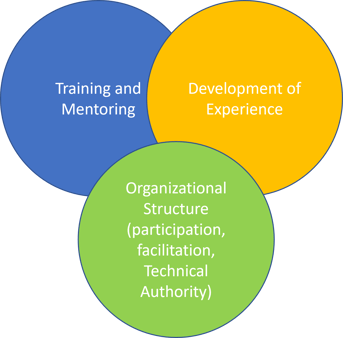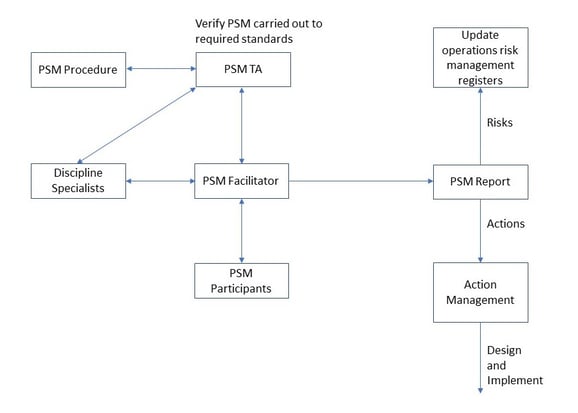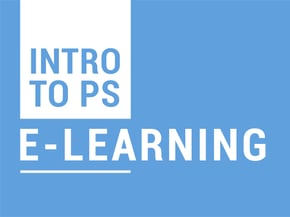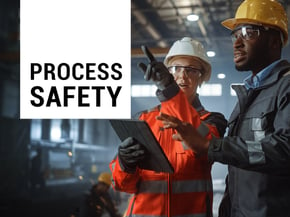Process Safety Blog
Executing on a PSM Competence Program
An effective Process Safety Management (PSM) program requires specific attention to the competence of its staff and leadership. Organizations such as the IChemE Safety Centre have provided a model to develop PSM competence however what is needed to execute such a vision? Here are some of my thoughts.
There are 3 key components to a PSM competence model.
- The PSM organizational structure - that has provision for participation, facilitation, and technical authority skills.
- The training and mentoring programs that need to be put in place to develop staff and leaders in PSM.
- The ongoing experience needed to maintain skills.

Many organizations establish PSM evangelists, however, 1 or 2 parts of the above competence model often have little attention.
Organization Structure and PSM Competence
The typical roles for PSM activities (such as HAZOP or LOPA) include:
- Facilitation – this can be internal or external
- Participants including discipline specialists – typically internal
- Technical Authority (TA) – this can be an internal or a trusted external resource.
The role of the facilitator and participants is well understood; however, the technical authority (TA) is key to maintaining standards across site(s), facilitators and external parties. The technical authority is typically the owner of the PSM procedures and approves any deviation(s) in the application of the procedures. The following flow chart is an example of how the TA interacts with other parties in the process.

|
|

|
|
| This INTRODUCTION TO PROCESS SAFETY online course is for all staff who work at hazardous facilities. FIND IT HERE! | Find out more about the discounted PROCESS SAFETY ESSENTIALS PACK HERE! | Prefer a face-to-face course? Find out about our next PROCESS SAFETY FOUNDATIONS course HERE! |
Guidance
- If the organization “outsources” its facilitation requirements, then it is important that the company put standards in place to ensure the practices used are a high standard. Internal staff (or trusted partners) will need to act as a TA, so training needs to be geared towards developing them to this level.
- Large organizations should look to develop technical authorities who develop the standards and approve the outputs from the various technical studies.
- Avoid the pure outsource model, where the external party is the “expert” and must not be questioned. I have seen several organizations that have had to re-work PSM studies after being questioned by the regulator. Develop some internal expertise and hold external parties to account.
Training and PSM Competence
Training courses are often considered as being a key component to developing competence, however, they are only part of the development picture. Training delivery can be performed through the following formats:
- Virtual on-demand (Introduction level)
- Face to face open courses using standard workshops (Facilitator or Introduction Level)
- Bespoke face to face courses for specific sectors and organizations (Facilitator or Introduction Level)
- Live Simulations of specific activities such as HAZOP or LOPA (Facilitator Level)
- 1 on 1 mentoring (Facilitator Level)
There are benefits of these different styles are as follows:
|
Style |
Key attribute |
Benefits |
|
Face to Face |
The trainer teaches the PSM material to trainee’s directly in a room setting or on-line.
|
Trainer can explain course content Trainer can more easily address gaps in knowledge (read the room) Trainee group interactions |
|
Virtual on demand |
Online, On-demand Learn as you go. |
Anytime, learn as you go. Ability to deliver “introductory” material to larger groups of people workforce. Can remove the need to teach introductory material in more advanced training, which can raise the quality of those sessions |
|
Bespoke |
PSM course material is customized to sector language and client scenarios. |
Examples and workshops are more relevant to participants which can lead to increased learning. |
|
Live Simulations |
PSM activities & competencies between trainee’s and trainer are simulated in a “live” setting. |
Real world experience in a “safe” environment Allows facilitators to be assessed independently as being competent. Feedback is part of workshops |
|
1 on 1 mentoring |
Conducted in a work setting.
|
Trainer/ senior staff member monitors the trainee progress in work setting and advises on how competence can be enhanced. |
The required style of training depends on the trainee’s current level of competence and the risk management goals of the organization.
Guidance
- Attendee's of PSM studies should be trained to introduction level.
- Some internal staff should be trained to "facilitator level", even if they are not facilitating.
- Facilitator training must be followed up with mentoring. Training alone is insufficient.
- Live Simulations with assessments and structured feedback should be core to facilitator orientated courses. This is often used in the HAZOP space, however, there is no reason why this cannot be done for more technically orientated training such as LOPA.
- Larger organizations should aim to develop bespoke training with sector relevant workshops.
Experience Development
After the training has been completed, a plan to consolidate and develop the skills is needed. This is especially important for facilitator training. The old saying “use it or lose it”, is relevant here. I believe for PSM activities, facilitators need to regularly perform their activities to be deemed competent. This is some guidance I have given a recent client.
|
Person |
Competency Requirements |
How to Achieve Competency |
|
LOPA/ HAZOP Technical Authority |
Expert in LOPA/ HAZOP Functional safety basics Process Safety Expert Expert in LOPA/ HAZOP procedure |
Facilitated 20 LOPA / HAZOP studies |
|
LOPA/ HAZOP Facilitator |
Facilitation skills Functional Safety basics (for LOPA) Process Safety Expert in LOPA/ HAZOP procedure |
Mentored across 3 LOPA/ HAZOP studies and signed off by LOPA/ HAZOP TA Facilitators to run at least 10 LOPA scenarios per year or 3 HAZOPs/ year to retain competence. This is applicable for both internal and external facilitators. Introduction to LOPA/ HAZOP training Process Safety Training – introduction level Functional Safety Basics training (LOPA) Facilitation training (as part of another course) |
|
LOPA/ HAZOP Participants |
Understanding of LOPA/ HAZOP process and procedure |
Introduction to LOPA or HAZOP training |
|
Discipline Specialists |
Understanding of LOPA/ HAZOP process and procedure |
Introduction to LOPA or HAZOP training |
|
Functional Safety Engineers |
Understanding of LOPA/ HAZOP process and procedure |
Introduction to LOPA or HAZOP training |
Ready to take your process safety strategy to the next level?
Build a strong foundation in process safety principles and regulatory requirements. Contact us to explore Process Safety Foundations Training for your workforce. Build your team’s understanding of core process safety principles with our Process Safety Essentials eLearning Pack.
Have questions or need guidance? GET IN TOUCH. We're here to help.


